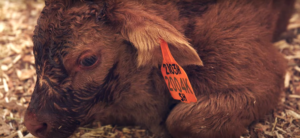7 Tips to Remember This Calving Season
Calving can be an exciting but challenging time. Whether you are in the middle of calving season, or planning for the next, the BCRC has several helpful calving resources to set yourself — and your calves — up for success. Here are seven calving tips to remember:
1. Do not hang calves upside down if they need help breathing.
If a newborn calf requires resuscitation, put them in the calf recovery position, poke a clean straw in their nose, dribble a few drops of water in their ear or rub them vigorously. Hanging calves upside down actually makes it more difficult for the calf to start breathing. Fluid that drains from a calf that is hung upside down mostly comes from the stomach, not the lungs, and gravity will make it more difficult for the lungs to expand. See a demonstration in this short video:
2. Intervene if the calf hasn’t received colostrum two to four hours after birth.
Colostrum not only provides the calf’s first immune system but also has many nutrients to give calves their best start. Good quality colostrum should be given between two to four hours after birth, but calves are able to absorb some antibodies up to 24 hours. Learn more in the video below.
3. Feed a minimum of 2L when tube feeding colostrum.
Tube feeding will cause fluids to go directly into the rumen rather than the abomasum as it normally does when calves suck. In the rumen, the valuable antibodies (IgGs) from the colostrum are broken down and will become unavailable to the calf. Feeding at least two liters allows the rumen to overflow and the calf to absorb the essential antibodies. Learn more about in this short video:
4. Have two tube (esophageal) feeders: one for sick calves and the other for healthy calves.
Having two designated feeders prevents disease and pathogen transmission from sick to healthy calves. Esophageal feeding, also known as “tube feeding” or “stomach feeding,” is essential when a calf is too weak to bottle feed but requires colostrum or dehydration treatment. Learn more about tube feeding in this short video:
5. Look for signs of dehydration so you can intervene early.
Being able to recognize the symptoms of disease and dehydration in baby calves is a simple and effective practice that can make a big mark on your bottom line. Being aware of behavioural cues like drooping ears, sunken eyes, lethargy and using the skin tent test can help you spot a dehydrated calf before serious consequences occur. Learn more in this short video:

6. Provide clean, dry bedding at calving to reduce disease transmission.
Dilution reduces pollution! The biggest percentage of calf loss occurs in the first seven days of life. Reduce the risk of exposure to harmful pathogens by providing animals a clean, dry place to calve, with sufficient space and ensure calves receive adequate, good quality colostrum. This can reduce disease transmission and encourage a healthy immune system. Learn more in this webinar recording:
7. Don’t rely on memory. Keep track of things like calving ease, calf loss and cow temperament at calving to help make better management decisions.
Keeping track of cow behavior and other maternal qualities is important to have an accurate understanding of your herd. Tracking calf loss and aggressive mothers will spotlight a repeat problem cow if it begins to happen multiple years and enables important culling decisions to be made. You can’t improve what you don’t track! Learn more in this webinar recording:
For more information and calving tips visit BCRC’s Calving and Calf Management topic page.
Click here to subscribe to the BCRC Blog and receive email notifications when new content is posted.
The sharing or reprinting of BCRC Blog articles is welcome and encouraged. Please provide acknowledgement to the Beef Cattle Research Council, list the website address, www.BeefResearch.ca, and let us know you chose to share the article by emailing us at info@beefresearch.ca.
We welcome your questions, comments and suggestions. Contact us directly or generate public discussion by posting your thoughts below.




